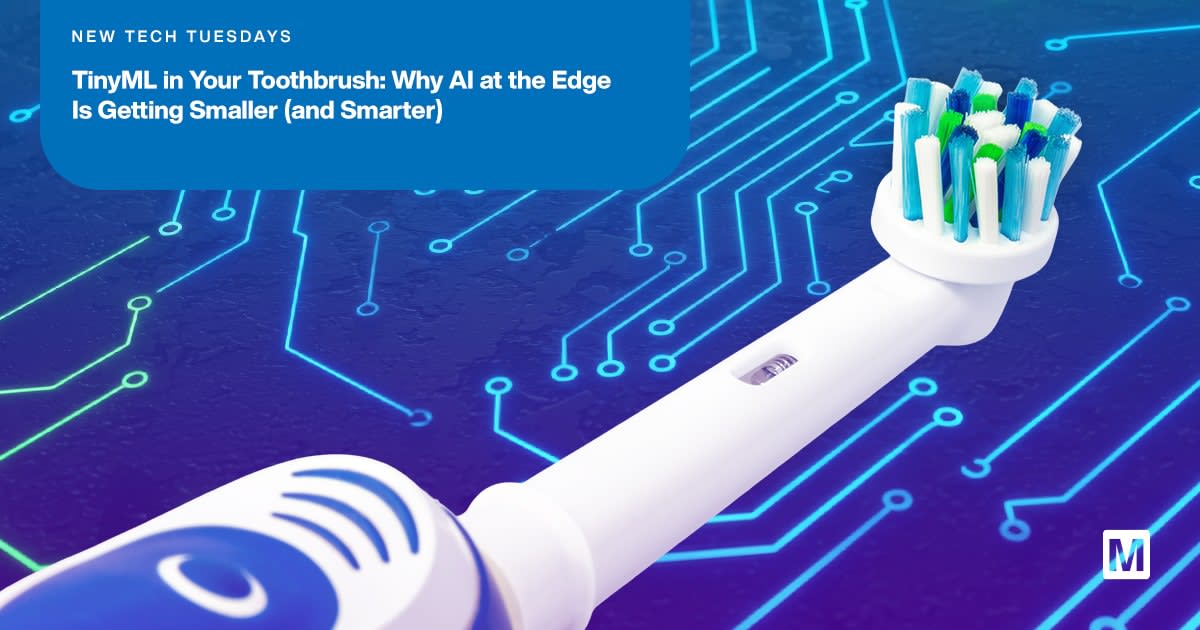TinyML in Your Toothbrush: Why AI at the Edge Is Getting Smaller (and Smarter)

New Tech Tuesdays
Join Mouser's Technical Content team for a weekly look at all things interesting, new, and noteworthy for design engineers.
Published October 14, 2025
The common electric toothbrush shook things up for at-home dental care when it was first released. However, the once-revolutionary instrument has been stuck in a battery-powered rut for a long time. Thanks to computing advances, toothbrushes are becoming smarter and taking personal oral health to new levels.
With some assistance from Tiny machine learning (TinyML), which is the application of ML technology on ultra-low-power devices like microcontrollers, artificial intelligence (AI) is now small enough to be embedded directly into everyday products, such as toothbrushes. With TinyML, smart toothbrushes are beginning to track brushing patterns, spot potential dental issues, or even respond to voice prompts, without ever pinging the cloud. And instead of the large, cloud-based AI models, it runs completely offline to deliver faster responses, more privacy, and lower energy consumption.
This week’s New Tech Tuesdays examines how AI is finding its way into smaller devices and changing the way we approach everyday dental care.
Why AI at the Edge?
Edge AI can now run entirely on small, battery-powered devices because of the advances happening in ultra-low-power microcontrollers, compact ML models, and optimized firmware. This emerging capability means tasks that used to need cloud servers can now be processed locally, using only a portion of the energy. For a toothbrush, this means instant brushing pattern analysis and feedback, as well as data protection, without relying on constant wireless connectivity.
How TinyML Fits into Toothbrushing
Breakthroughs in edge AI hardware, miniature sensors, and TinyML techniques are giving toothbrushes capabilities beyond standard cleaning. As a result, features that were once exclusive to advanced medical equipment are now being spotted in everyday oral care. Here are some examples:
- Tooth-resonance diagnostics: The ToMoBrush project uses a sonic toothbrush to analyze the sound a user's teeth make while brushing, enabling the detection of problems such as cavities, tartar, or food stuck between teeth, with about 90 percent accuracy.[1]
- TinyML brush timers that automatically activate: Using a lightweight TinyML model, these systems detect brushing motion from an accelerometer and automatically start or stop the timer.[2]
- AI-powered full-mouth cleaners: The Feno Smartbrush uses a U-shaped bristle array with a built-in camera to adapt cleaning in real time, aiming for full-mouth coverage in just 20 seconds.[3]
- Real-time feedback and coaching: Many new connected brushes combine pressure sensors, motion tracking, and Bluetooth® apps to create 3D maps of a user’s mouth.[4] From these insights, AI analyzes the brushing style and provides personal guidance (Figure 1).

Figure 1: A connected toothbrush pairs with a mobile app to map brushing coverage and provide real-time feedback for improved oral care. (Source:SKfoto/stock.adobe.com)
The Electronics Combo Making This Possible
Smart toothbrushes rely on ultra-low-power processors with the ability to run ML models that have been compressed to work within strict memory and energy limits. To keep the software efficient, the firmware uses quantization, which reduces the precision of numbers in the model to conserve memory and accelerate calculations, and model pruning, which removes parts of the model that do not impact accuracy. Data is collected from miniature sensors, including accelerometers, gyroscopes, magnetic field detectors, and acoustic pickups, which track motion, position, and vibration. Power management through duty cycling, event-driven wakeups, and local processing allows these devices to run for long periods on small batteries while still delivering real-time, context-aware feedback.
The Newest Products for Your Newest Designs®
While TinyML handles the “thinking,” the precise data input necessary for such analysis comes from sensors. The Melexis MLX90427 is one example of a high-performance sensor suitable for edge AI systems. It uses Triaxis® Hall technology to capture magnetic flux in three dimensions, enabling precise 360° rotary or joystick-style position sensing. On-chip digital signal processing (DSP) helps maintain accuracy by correcting for temperature drift and stray magnetic fields, while full-duplex serial peripheral interface (SPI) and dual-die redundancy options guarantee flexibility and reliability. Since the MLX90427 is designed for demanding environments, it operates from −40°C to +160°C and meets automotive-grade standards for durability.
Tuesday’s Takeaway
AI at the edge is getting smaller, faster, and more efficient, which is why it is appearing in unexpected places. By combining low-power microcontrollers, efficient ML models, and precise sensors, engineers can create products that process data locally and respond instantly.
In oral care, this means toothbrushes that coach, scan teeth for potential issues, and adapt performance in real time. Similar capabilities are expected to transform other everyday tools, turning once-simple devices into autonomous, data-driven systems.
Sources
[1]https://arxiv.org/abs/2402.01933
[2]https://doi.org/10.3390/hygiene5010005
[3]https://feno.co/pages/personalized-u-shaped-toothbrush
[4]https://oralb.com/en-us/oral-b-app/